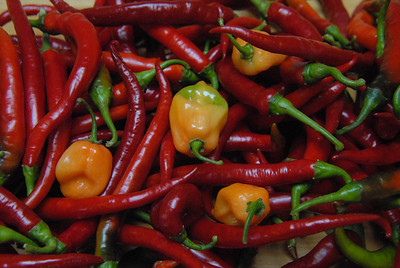A few weeks ago I faced an unusual culinary dilemma: What to do when friends drop by with two pounds of freshly picked chili peppers? On that afternoon I wasn’t up for stuffing, coating and frying the peppers for a fiery take on chilies rellenos. Nor did I anticipate making several gallons of spicy pico de gallo. Forget about hosting a scorching, week-long celebration of Mexican, South American, South Indian and Thai food. So, just what would I do with all these potent veggies?

For centuries cooks have faced a similar quandary. In Mexico chilies have been cultivated since at least 3,500 B.C. Thanks to Portuguese and Spanish explorers who transported these plants around the globe, Indian and Southeast Asian chefs started dabbling with chilies in the 15th century. By the mid 16th century Europeans had incorporated them into their recipes.
Although I normally associate chilies with heat, these early cooks added them for flavor. Chopped or ground up, dried or roasted, the peppers enhanced countless regional dishes. Ultimately, they became renowned not as a vegetable but as a spice or seasoning. Not much has changed in five centuries. They still appear primarily in condiments and are the main ingredient in such classics as chili paste, Tabasco sauce and chili pepper salad dressing.
Chilies get their heat from capsaicin, a compound found in the white membrane to which pepper seeds cling. Because they proportionally contain more seeds and tissue, small chilies tend to be hotter than large ones. Short, lantern-shaped habaneros and Scotch bonnets rank among the strongest. Long, slender Anaheims are among the mildest.
The only way to reduce a chili’s intensity is to remove its seeds and membranes. Remember either to wear gloves while or wash your hands after doing this. Otherwise, depending on the pepper variety, you may burn your skin.
By stringing chili peppers and making ristras, you can avoid the risk of burnt fingers and faces. This is what my friends and I did. Yet, if you opt to turn your chilies into a sauce, try Unlucky Thirteen Sauce. It’s guaranteed to be a fiery hit.
UNLUCKY THIRTEEN SAUCE
Recipe courtesy of Paul Oliver, writer, creator of the literary blog The Devil’s Accountant and hot sauce aficionado
1 chipotle pepper, found in the dried goods area of produce sections
12 habanero peppers (lessen the number of these peppers and de-seed to lesson the heat of the sauce)
3-6 garlic cloves, to taste
1/2 yellow onion, quartered
1 bottle of white vinegar
3oz (1/2 of a Cento can) of tomato paste
4 tablespoons of salt
1 tablespoon of sugar
Place the chipotle pepper in a small saucepan filled with water, place it on low heat and allow it to soften.
Cut the habanero peppers and garlic in half. Place them and the onion in a medium sized pot. Pour in the white vinegar until the peppers float or all the ingredients are covered. Add the salt, sugar, tomato paste and the softened chipotle and bring the entire mixture to a boil. Note that you should be wary of the pot as it begins to boil for the vinegar and capsaicin in the peppers produce an irritating vapor. As soon as the ingredients begin to bubble, stir and remove from the heat. You want to heat but also to avoid fully cooking any of the ingredients. By not stewing the ingredients, you will get a “fresher” pepper flavor and minimize the vapor.
Pour the sauce into a blender or food processor and blend on low. Be sure to set it on a low, especially if you are doing this with a blender. You DO NOT want to have this stuff spraying everywhere. Slowly increase the speed, mixing until the sauce is completely smooth. Note that, if you’ve left the seeds in the peppers, you’ll have to blend for a longer period of time.
Place the sauce in a glass container (mason jars are great) and refrigerate. Once cooled, it is ready to use, although allowing it to rest for 1 to 2 weeks is highly recommended.
*A FEW TIPS FOR UNLUCKY THIRTEEN SAUCE
Do not use aluminum pots/pans for this. The capsicum and vinegar will pit them.
Wash before, during and after this whole process. Do it thoroughly. You do not want to forget to do this.
Let the sauce sit. It really does get better after a week or so of sitting in the fridge. Be ready, though, for this smokey, citrusy hot sauce is not for the faint.